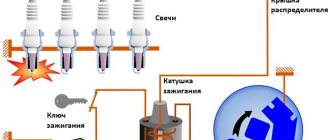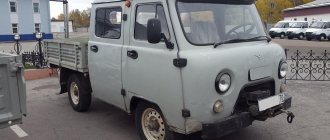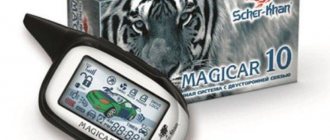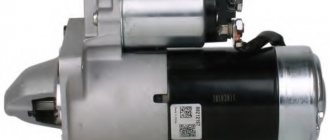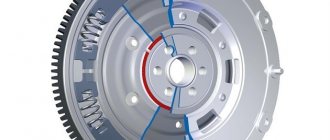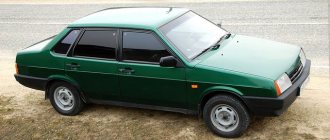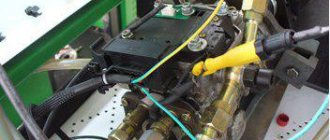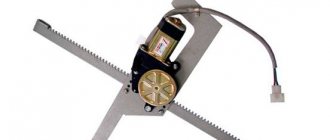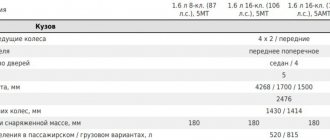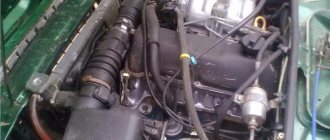Volzhsky Auto in 1982, and the last car left the assembly line 30 years later. The VAZ 2107 was originally planned as a luxury version of the previous fifth model. The car has a sedan-type body and rear-wheel drive, a comfortable interior and improved engine performance. The car turned out to be extremely successful and is still popular among Russians.
The car is easy to drive thanks to the hydraulic clutch, large steering wheel and optimal gear ratios. The VAZ 2107 model belongs to the so-called classic series, the prototype for which was the legendary “kopek” and the Italian Fiat 124. The manufacturer did not plan to install front-wheel drive; the “eight”, “nine” and “ninety-nine” were launched into the series. Such developments were carried out exclusively by enthusiasts, and perhaps some projects were implemented.
VAZ 2107 front wheel drive
VAZ 2107 front-wheel drive - is this realistic, since VAZ 2107 are rear-wheel drive cars?
And in general, why remake the car so radically? The question is by no means rhetorical: for many car enthusiasts with a VAZ 2107, front-wheel drive would be preferable - they say it doesn’t get stuck so much in mud and snow and skids less on the road. However, although the problem of snow and mud is very relevant in our country, you should not devalue rear-wheel drive and headlong try to “shove in something that cannot be shoved in” - in this case we are talking about the VAZ 2107, or more precisely about changing rear-wheel drive to front-wheel drive - experienced drivers will say that stability a car on the road practically does not depend on the drive – it’s all a matter of driving technique and skill, you can get stuck in such a way with a front-wheel drive that it won’t seem too much. So the question is “why?” does not disappear - on the contrary, even more “emerges”.
It is possible to convert a VAZ 2107 to front-wheel drive only as an experiment, if you have the funds, direct hands and great enthusiasm. Such an impulse is akin to a boyish desire to mix saltpeter “wow with this powder” just to see whether it will bang or not, there is, of course, the risk that all the arms and legs will be torn off to the “edreni-feni” (yes, he is simply huge), but it itches It’s just one natural science place. So here too - the VAZ 2107, in case of unsuccessful transformation to front-wheel drive, can simply be scrapped.
The drive of a car is not just front or rear drive wheels - the location of the systems and important components of the car, even the engine itself, depends on what it is. If someone decides to change rear-wheel drive to front-wheel drive on their VAZ 2107, they should inquire about how much work is ahead - a lot of welding will need to be done. And the result is a miracle of technical thought, about which one can still argue: “whether it will fly or not.”
Source
Front-wheel drive VAZ 2107: device features and characteristics
Volzhsky Auto in 1982, and the last car left the assembly line 30 years later. The VAZ 2107 was originally planned as a luxury version of the previous fifth model. The car has a sedan-type body and rear-wheel drive, a comfortable interior and improved engine performance. The car turned out to be extremely successful and is still popular among Russians.
The car is easy to drive thanks to the hydraulic clutch, large steering wheel and optimal gear ratios. The VAZ 2107 model belongs to the so-called classic series, the prototype for which was the legendary “kopek” and the Italian Fiat 124. The manufacturer did not plan to install front-wheel drive; the “eight”, “nine” and “ninety-nine” were launched into the series. Such developments were carried out exclusively by enthusiasts, and perhaps some projects were implemented.
Weight of passenger cars in tabular format
We present to your attention a table that shows the weight of the car by brand.
| car model | Curb weight |
| Weight of the Oka 1111 car, weight of the Okushka | 635 kg |
| Weight of the car Oka 1113 | 645 kg |
| Weight of a VAZ 2101 car, weight of a penny | 955 kg |
| Weight of the VAZ 2102 car | 1010 kg |
| Weight of the VAZ 2103 car | 965 kg |
| Weight of the car VAZ 2104, weight of tens 2110 | 1020 kg |
| The weight of the VAZ 2105 car, the weight of the five | 1060 kg |
| Weight of the VAZ 2106 car, weight of the six | 1045 kg |
| Weight of the VAZ 2107 car, weight of the seven | 1049 kg |
| Weight of the VAZ 2108 car | 945 kg |
| Weight of the VAZ 2109 car, weight of the nine | 915 kg |
| Weight of the VAZ 2111 car | 1055 kg |
| Weight of a VAZ 2112 car, weight of a twelve-wheeler | 1040 kg |
| Weight of the VAZ 2113 car | 975 kg |
| Weight of the VAZ 2114 car, weight of the four | 985 kg |
| Weight of the VAZ 2115 car, weight of the tag | 1000 kg |
| Weight of the VAZ 2116 car | 1276 kg |
| Weight of the VAZ 2117 car | 1080 kg |
| Weight of the Niva 2121 car | 1150 kg |
| How much does a Chevrolet Cruze weigh (Chevrolet Cruze weight) | 1285-1315 kg |
| How much does a Chevrolet Niva weigh (Chevrolet Niva weight) | 1410 kg |
| How much does a GAZ (Volga) weigh, the weight of a Volga is 24 | 1420 kg |
| How much does GAZ 2402, GAZ 2403, GAZ 2404 weigh? | 1550 kg |
| How much does GAZ 2407 weigh? | 1560 kg |
| Car weight Moskvich 314 | 1045 kg |
| Weight Moskvich 2140 | 1080 kg |
| Weight Moskvich 2141 | 1055 kg |
| Car weight Moskvich 2335, 407, 408 | 990 kg |
| How much does a UAZ 3962, UAZ 452 weigh, how much does a UAZ loaf weigh? | 1825 kg |
| How much does UAZ 469 weigh? | 1650 kg |
| How much does UAZ Patriot weigh? | 2070 kg |
| How much does UAZ Hunter weigh? | 1815 kg |
| How much does Nissan weigh (weight of nissan x-trail car) | 1410-1690 kg |
| How much does Qashqai weigh (weight of Nissan Qashqai car) | 1297-1568 kg |
| How much does a Nissan Juke weigh (Nissan Beetle weight) | 1162 kg |
| Ford Focus car weight (how much does a Ford Focus weigh) | 965-1007 kg |
| Weight of the Ford Focus 2 car (how much does the Ford Focus 2 weigh) | 1345 kg |
| Weight of the Ford Focus 3 car (how much does the Ford Focus 3 weigh) | 1461-1484 kg |
| Ford Kuga car weight (how much does a Ford Kuga weigh) | 1608-1655 kg |
| Weight of the Ford Escort (how much does the Ford Escort weigh) | 890-965 kg |
| Weight of the Renault Logan car (how much does the Renault Logan weigh) | 957-1165 kg |
| Renault Duster car weight (how much does a Renault Duster weigh) | 1340-1450 kg |
| Renault Sandero car weight (how much does a Renault Sandero weigh) | 941 kg |
| Weight of the Opel Mokka car (how much does the Opel Mokka weigh) | 1329-1484 kg |
| Weight of the Opel Astra car (how much does the Opel Astra weigh) | 950-1105 kg |
| Mazda 3 car weight (how much does mazda 3 weigh) | 1245-1306 kg |
| Weight of the Mazda CX-5 (how much does the Mazda CX-5 weigh) | 2035 kg |
| Mazda 6 car weight (how much does mazda 6 weigh) | 1245-1565 kg |
| Volkswagen car weight (how much does a Volkswagen Tuareg weigh) | 2165-2577 kg |
| Weight of a Volkswagen Polo car (how much does a Volkswagen Polo weigh) | 1173 kg |
| Weight of the Volkswagen Passat car (how much does the Volkswagen Passat weigh) | 1260-1747 kg |
| How much does a Toyota Camry weigh (weight of a Toyota Camry) | 1312-1610 kg |
| How much does Toyota Corolla weigh (weight of Toyota Corolla) | 1215-1435 kg |
| How much does a Toyota Celica weigh (Toyota Celica weight) | 1000-1468 kg |
| How much does a Toyota Land Cruiser weigh (Land Cruiser weight) | 1896-2715 kg |
| How much does the Skoda Octavia weigh (weight of Skoda Octavia) | 1210-1430 kg |
| How much does the Skoda Fabia weigh (Skoda Fabia weight) | 1015-1220 kg |
| How much does the Skoda Yeti weigh (Skoda Yeti weight) | 1505-1520 kg |
| How much does a Kia Sportage weigh (KIA Sportage weight) | 1418-1670 kg |
| How much does Kia Sid weigh (weight of KIA Ceed) | 1163-1385 kg |
| How much does the Kia Picanto weigh (KIA Picanto weight) | 829-984 kg |
Thus, it turns out that if we take, so to speak, “in general for the hospital,” then the average weight of a passenger car is approximately from 1 to 1.5 tons, and if we talk about SUVs, then the whole weight already shifts from 1.7 tons to 2. 5 tons.
weight of a passenger car, how much does OKA weigh, how much does a car weigh, weight of a car, how much does a Matiz weigh, how much does a Matiz weigh, weight of a Skoda car, weight of an Audi
Source: cxt.su
Model description
The VAZ “Seven” was called “Soviet Mercedes” for its exterior; the car has a radiator grille of a very characteristic shape. On the technical side, the car was well equipped for its time:
- vacuum brake booster;
- hydraulic clutch;
- powerful engine;
- efficient optics.
The design of the car provides for drive to the rear axle; initially the gearbox was four-speed. The VAZ 2107 model is, in fact, the logical conclusion of the entire classic line, and further modernization would require a significant reworking of the entire structure. The development of cars with front-wheel drive or all-wheel drive was carried out within other lines.
Model modernization
The VAZ 2107 was produced virtually unchanged until 2012 in Russia and abroad. Among the most significant technical solutions implemented on the machine was the installation of an injector and certification in accordance with EURO-2 requirements. On luxury models, the installation of an electric power steering was provided; a hydraulic drive for these purposes turned out to be too difficult to implement.
The modernized version of the VAZ 2107, along with obvious advantages, also received a number of disadvantages. Time-tested systems such as a hydraulic clutch drive or others do not cause any complaints, but the exhaust gas exhaust system clearly turned out to be far from ideal. When installing a full set of equipment for it, the designers replaced the front resonator with a catalytic converter, which significantly reduced the ground clearance.
Equipment for chip tuning
In order to implement chip tuning of VAZs, we will need special equipment. I became interested in this topic for a very long time, but there was no opportunity to test it thoroughly, since there was no suitable equipment, but recently I was lucky enough to become the owner of such a set of equipment for chip tuning (PAK loader v.3.0). Naturally, I immediately wanted to flash something. And the first car I flashed was a VAZ 2107.
The seven was 2007 and the brains there were January M7.3 Avtel 21067-1411020-21 open type. The native firmware was A327RC07.
After reading various forums, we decided that we would install the firmware based on our native software; the choice fell on the Euro 2 firmware from Sergei Vasilyevich. According to the author, this firmware provided good dynamics and optimization of consumption.
Article on the topic: What does this mean?
Unclaimed projects
The experimental design production of the car plant, in collaboration with developers, worked on promising concepts based on the existing platform. Various options were proposed, including front-wheel drive for the seven. The designers' achievements remained unclaimed; too much would have to be redone, including replacing the reliable hydraulic clutch drive with a cable one.
The latest developments on the VAZ 2107 model involved more external changes, what is commonly called restyling. A team of designers worked on the car; they did not touch upon technical issues; all components and systems, such as the clutch drive, distributed injection and electronic engine control unit, were preserved intact. The front and rear bumpers, hood and other elements have changed beyond recognition. However, the project remained unclaimed.
Source
How is 21074 different?
The main and, perhaps, the only difference from the beds of other sevens of various modifications is in the engine. This is a 1.6-liter (more precisely, 1,569 cc) engine with a cast-iron Fiat block and an aluminum head. Initially, the engine ran only on 93-octane gasoline, but later the compression ratio was lowered to allow the vehicle to be operated on lower grades of fuel. Since the power system still remained carburetor, there was not much difference. The seven happily consumed about 10 liters of fuel in mixed mode.
Seventy-five power and 116 Nm of torque look helpless by modern standards, but then for the country that built communism, it was proletarian chic. Even the Volga was more powerful by only a dozen forces. Toward the end of its career, 21074 still received distributed injection, although it was a different modification, 21074-10, which met Euro2 standards, and the next year an even more advanced seven 21074-20 with an injector appeared, which could meet Euro3 standards. But the injection versions of the six engine completely abandoned 92 gasoline and required only high-octane 95 gasoline.
Sources
- https://aprilvlad.ru/avto-opyt/moshchnost-2107.html
- https://RussoAuto.ru/auto/vaz/vaz-2107
- https://uhta-trans.ru/remont/vaz-2174.html
- https://old-vaz.ru/texnicheskie-xarakteristiki-vaz-2107.html
- https://ladamaster.com/tekhnicheskie-kharakteristiki-vaz-21074
- https://avto-all.com/rossiyskie-avtomobili/vaz-21074-inzhektor-mozhno-smelo-nazvat-obnovlennoy-semerkoy
[collapse]
VAZ 2107 with front wheel drive
Is such a car relevant?
This car remained to decorate the museum!
The car has become more attractive
Some kind of crap, where is the attractiveness here? It would be better if the VAZ 2151 was launched in 2002(
If it cost 200 thousand rubles like a classic, then it would be in great demand. All you need to do is strengthen the body!
The main thing is that the injection engine 2106 and the reinforced gearbox from Svyatogor 2141 remain!
A rear beam from Svyatogor would make a very attractive car.
The only thing worse than this is the cherry smile.
VAZ 2107 - review of the pros, disadvantages and features of the car
It is difficult to find a person who is not familiar with the VAZ 2107. For some, the “Seven” is a pleasant memory from childhood, for others it is their first car. Many Zhiguli drivers studied the structure of the vehicle. Despite the fact that the car has not been produced for more than 8 years, you can find it in every city. Moreover, the owners are not trying to get rid of this car, but continue to use it with joy and even pride. What is the reason for the popularity of the model and why is it still making history? Let's find out in our article.
This section is not under development
autodelo. info
autodelo. info Passenger Motorcycles Trucks and Commercial Engines
- For novice drivers
- Code of Administrative Offenses
- Region codes
- Legal issues
- Insurance
- Adviсe
- News
- Test Drive
- Interesting
- Online services
Sorry…
To main
- about the project
- Rules
- Contacts
“Car catalog and all the news from the world of car lovers”
A little history
The first “seven” rolled off the assembly line of the Volzhsky Automobile Plant in March 1982. It became a luxury version of the VAZ 2105 model produced at that time. The “Seven” almost completely repeated the architecture of its predecessor, but differed from it in a slightly modified appearance, comfortable seats and more powerful propulsion systems. In general, the entire line of Zhiguli cars included a rich assortment of engine modifications, and the “seven” was no exception.
Especially for the needs of the KGB and the Ministry of Internal Affairs, AvtoVAZ produced a limited number of “sevens” with a rotary piston engine. Its volume was 1.3 liters with 140 hp. power. This modification was not produced for long - from 1986 to 1991.
OJSC AvtoVAZ produced the VAZ 2107 not only for the domestic but also for the foreign market. The car was exported under the names LADA 1500, LADA Signet, LADA Riva and LADA Nova.
Production of the "Seven" was discontinued at the beginning of 2012. It was replaced by LADA Granta.
Exterior
It was difficult to call the appearance of the VAZ 2107 attractive even during the years of its release. However, there are still some highlights in its exterior: large rectangular headlights, ideally combined with a powerful radiator grille and a slightly raised hood, give the “look” of the model an aggressive squint. The predatory image is complemented by a wide plastic bumper with chrome trim.
The side of the car includes a straight body stamping, emphasizing the large silhouette of the model, wide doors with large windows, providing ideal all-round visibility for the driver, and blown wheel arches, inside of which there are 13-inch wheels.
The rear optics are horizontally divided into sections. The trunk lid, unlike its predecessor, was not decorated with decorative kinks.
Each body element of the “Seven” emphasizes the strict style of the car.
Interior
Because The VAZ 2107 was positioned as a luxury version of the VAZ 2105; almost all interior elements had certain modifications. For example, the front row of seats has integrated headrests. At the same time, the seating itself has also changed - the chair has taken on the shape of a bucket, which supports the spine well.
The instrument panel, taken as a basis from the “five”, has also been modernized: the speedometer now has digitization up to 180 km/h. Among the instruments, a tachometer and an oil pressure indicator were added. In the central part of the dashboard, engineers installed cold air deflectors, which made it possible to cool the interior of the car. Moreover, ventilation was created only under the pressure of the oncoming air flow at speed.
The 4-spoke steering wheel had a concave hub and was somewhat reminiscent of the design of the VAZ 21213 steering wheel. Now the interior of the “Seven” is causing some criticism: drivers find the interior boring. However, during the years the model was produced, its interior was considered quite cozy.
Salon
The interior features comfortable front seats with integrated headrests.
There is not much space in the back of the Seven, this is a significant disadvantage of this car. You will be surprised, but there is a clock on the main panel. Why are you surprised? A similar element is installed in luxury cars, for example, the Infiniti QX70, Mercedes s-class. Above the glove compartment there is a stylish trim with the Lada inscription.
The front panel here is very narrow, like in the Gelika, which we already mentioned earlier. This choice was not made by the engineers in vain, because by reducing this part the size of the entire cabin increases.
Specifications
Technical characteristics of the VAZ 2107 are presented in the table below.
| Parameter | Index |
| Length, mm | 4145 |
| Width, mm | 1620 |
| Height, mm | 1440 |
| Ground clearance, mm | 175 |
| Front track, mm | 1365 |
| Rear track, mm | 1321 |
| Wheelbase, mm | 2424 |
| Weight, kg | 1049 |
| Fuel tank volume, l | 39 |
Throughout the history of the car, many engine modifications were installed in it, and all of them were equipped with 8 valves. Among them, the most common motors were:
- 1.3 l, 64 hp, maximum speed – 140 km/h,
- 1.5 l, 71.4 hp, maximum speed – 145 km/h,
- 1.6 l., 75 hp., maximum speed – 156 km/h,
These engine types were installed in combination with 4- and 5-speed manual transmissions.
Total information
| Options | VAZ 2107 | VAZ 21074 | VAZ 2107-20 | VAZ 21074-20 |
| Weight of the equipped vehicle, kg | 1060 | 1060 | 1060 | 1060 |
| Payload, kg | 400 | 400 | 400 | 400 |
| Permitted maximum weight, kg | 1460 | 1460 | 1460 | 1460 |
| Ground clearance of a vehicle with a permissible maximum weight, with tires 175/70 R13, not less, mm: | ||||
| to the front suspension cross member | 162 | 162 | 162 | 159 |
| to the rear axle beam | 157 | 157 | 157 | 154 |
| Permissible weight of cargo on the additional (top) luggage rack, kg | 50 | 50 | 50 | 50 |
| Maximum speed, km/h: | ||||
| with permissible maximum weight | 148 | 148 | — | — |
| with driver and passenger | 150 | 150 | 150 | 150 |
| Acceleration time from standstill to 100 km/h, s: | ||||
| with driver and one passenger | 17 | 16 | 17 | 16 |
| with permissible maximum weight | 19 | 17,5 | — | — |
| Minimum turning radius along the track of the outer front wheel, m | 5,6 | 5,6 | 5,6 | 5,6 |
| The greatest rise overcome by a car with a permissible maximum weight without acceleration in first gear, % | 36 | 36 | 36 | 36 |
Advantages and disadvantages
Speaking about the "seven", it is difficult not to dwell on its strengths and weaknesses. Let's start with the strong ones:
- high ground clearance. Thanks to this indicator, the car can easily drive onto curbs and move along snow-covered roads. On country roads the Lada also behaves confidently,
- economical consumption. With a calm driving style, fuel consumption in the “seven” will be quite economical. In the city the car consumes -8.5-8.9 liters, on the highway - 7.6-8.2 liters, in mixed mode - 8.1-8.6 liters,
- cheap repairs. The “Seven” can be repaired at very reasonable prices. Spare parts are always available in auto stores, so this procedure cannot be called long,
- soft plastic. The interior of the car, although it looks simple, is made of high-quality material. The plastic used to decorate the dashboard does not creak in the cold and on bumps,
- simple architecture that allows you to repair your car yourself. Even a person who knows nothing about the structure of a vehicle will be able to navigate the nodes of the “seven” without any problems in just a couple of years.
Engines
| Options | VAZ 2103 | VAZ 2106 | VAZ 2104 | VAZ 21067 |
| Number and arrangement of cylinders | four-cylinder, four-stroke, in-line | |||
| Supply system | carburetor | distributed injection | ||
| Octane number of gasoline | 92-93 | 95 | ||
| Cylinder diameter and piston stroke, mm | 76×80 | 79×80 | 76×80 | 79×80 |
| Cylinder operating order | 1-3-4-2 | |||
| Compression ratio | 8,5 | 8,5 | 8,5 | 8,5 |
| Working volume, l | 1,45 | 1,57 | 1,45 | 1,57 |
| Rated power, according to GOST 14846 (net), kW (hp) | 52,5 (71,4) | 54,8 (74,5) | 50,0 (68,0) | 54,5 |
| Crankshaft rotation speed at rated power, min-1 | 5600 | 5600 | 5000 | 5000 |
| Maximum torque at crankshaft speed 3400 min-1 (3000 min-1 for VAZ 2106 engine), N*m | 103,9 | 116 | — | — |
| Minimum crankshaft rotation speed, min-1 | 850-900 | 850-900 | 820-880 | 820-880 |
| Direction of rotation of the crankshaft from the pulley side | right | |||
| Lubrication system | combined, pressure and spray | |||
| Cooling system | liquid, closed, forced circulation | |||
| Crankcase ventilation system | forced, with crankcase gases vented into the intake manifold |
Options
It’s difficult to call the VAZ 2107 equipment rich; it does not include a large number of options and goodies. It has only the necessary minimum: three-point seat belts, hydraulic headlight range control, and a full-size spare wheel. Unfortunately, the “Seven” is not equipped with power steering, so it is quite difficult for representatives of the fairer sex to drive the car. The car never dreamed of air conditioning and electric windows. This is understandable: the manufacturer was afraid that the rise in price of the car would negatively affect its demand.
Control
When getting behind the wheel of a VAZ 2107, the driver should remember the features of driving a rear-wheel drive vehicle. It is difficult to get used to, so it is recommended not to exceed the speed of 50 km/h at first. Due to the lack of power steering, the car is difficult to control; the driver has to apply force to take turns. You can’t play chess on the “seven” among dense city traffic - it’s clumsy. The steering wheel, as a rule, has a lot of factory play.
The brakes are ineffective. The front ones are disc, with a two-piston caliper, the rear are drum, with one working cylinder and two pistons. The front suspension is independent, spring, the rear suspension is dependent, spring.
One brand - different approach to design: who is sharper on the move
“Seven” is a direct successor to the Fiat 124, which was developed back in the 1960s of the last century. Compared to modern cars, it has neither a smooth ride, nor steering sharpness, nor composure. At high speeds the car floats, so it feels completely uncomfortable on the highway. But the cross-country ability due to the ground clearance of 170 mm is excellent.
And because of the rear-wheel drive platform, the car can be turned from a boring family sedan into a drift car for winter rides. True, for these purposes the suspension will have to be modified.
At the front, the “nine” has an independent MacPherson strut, and the “seven” has double wishbones. The designs are simple, reliable and rarely present “surprises”. Most often, ball joints and wheel bearings fail in both cars. The cost of parts is from 500 to 1,000 rubles, replacement will cost about the same. The Sema's rear brake cylinders also become sour - we recommend changing them as often as the pads.
Is it necessary to buy a used VAZ 2107?
Before buying a VAZ 2107, answer yourself the question: “Why do I need it?” If you are looking for a “workhorse” that can carry heavy loads, get you to work and not require special attention, then the “seven” is quite suitable for you. However, if you need a comfortable car that can take you thousands of kilometers from home without breakdowns or failures, then you will have to familiarize yourself with the list of alternative cars. No matter how excellent the “Seven” has, it will never be able to provide its owners with comfort and safety. A rigid suspension, a stool-like seating position and a short wheelbase will cause discomfort, numbness in the limbs and longitudinal rocking. Driving long distances in such conditions is difficult.
At the same time, this machine is ideal for “short runs”: it is compact, economical and durable. It is advisable to purchase it for commercial purposes.
When buying a used car, keep the following tips in mind:
- check its “purity”. In the report on the car you will see whether it is burdened with restrictions, study the mileage history, get acquainted with the number of owners,
- invite an independent expert to inspect the “Seven” or, if you figure it out yourself, thoroughly examine the condition of the vehicle,
- Avoid cars with high mileage. Remember the rule “the higher the mileage, the closer the overhaul.” It is extremely reckless to invest money in a vehicle that is not already cheap; it is better to look for a more “fresh” copy. You should also remember: in “Sevens” with a mileage of 180 thousand km, the chain guides often fail, the tightness of the cooling system is broken, the gearbox breaks, and problems begin with the gearbox. With the most careful care, the engine will last up to 250-260 thousand km without repair.
Alternatives
VAZ 2107 is a rear-wheel drive domestic sedan belonging to the B-class. He has many competitors. Among them, particularly popular models produced simultaneously with the “seven” should be highlighted:
- Lada Priora. This domestic sedan actively competed with the VAZ 2107. It has a more attractive appearance, rich technical equipment and a comfortable interior. Priora was produced in three engine versions: sedan, hatchback and station wagon.
- Mitsubishi Galant. This Japanese beauty was produced simultaneously with the domestic Zhiguli. Buying a new Galant at that time was problematic - the pleasure was too expensive. However, now on the secondary market prices for both models have leveled off. By paying a penny, you can become the owner of a powerful, spacious sedan that can comfortably seat five people and take them to the ends of the world. However, it should be remembered that the old Galant requires large financial investments.
- Chevrolet Lacetti. Another foreign model that can lure potential buyers to its side. Nimble and roomy, it is perfect for daily use. It is noteworthy that the car is equipped with air conditioning, which is so necessary in the summer and which is so lacking in the “seven”. Spare parts for the Lacetti are inexpensive, but high quality. They can always be found in any auto store. The car, by the way, is capable of dynamic acceleration, so operating it in city conditions is a pleasure.
- Moskvich 2140. This is the cheapest competitor to the Seven. It was produced between 1976 and 1988. This Soviet car has rear-wheel drive, poor equipment and a 70 hp carburetor engine. At one time, Moskvich 2140 was in high demand not only on the Russian market, but also in Finland, Greece, and Scandinavia. The car was purchased both for personal use and for government needs. Despite the fact that the car left the production line more than 32 years ago, perfectly preserved examples with low mileage can be found on the secondary market.
Owner reviews
Owner reviews will help you finally figure out whether this car is worth purchasing.
This is my first car. I bought it in 2007 and drove it for almost five years. The “Seven” only broke down a couple of times – there were problems with the fuel pump and the intake pump, but otherwise there were no complaints. Yes, the car is not ideal: it consumes a lot of gasoline, has an uncomfortable seating position, and is a bit cramped for passengers, however, it coped with severe frosts and severe off-road conditions. I remember her with nostalgia. On the highway the car behaved confidently, however, it could not accelerate more than 120 km/h - it was scary. In the city, thanks to its compact size, it is always easy to park. The high ground clearance even allowed it to drive onto curbs. Overall there are only pleasant memories left.
The main advantage of this machine is its cheap spare parts, which are always available in stores. I inherited the “Seven” from my father, and at first I couldn’t get used to it: small, angular, cramped... But as I used it, I realized that the car was not bad! He is passable and durable. Not picky about fuel. It starts in cold weather and quickly warms up the interior. The VAZ 2107 traveled with me for about 60 thousand km, after which it was successfully sold. By the way, literally the next day after the announcement of the sale was published, a buyer was found who did not even bargain, but took the car for the price I specified. “Sevens” will sell like “hot cakes” at any time, because they are reliable and durable. Minor breakdowns occur frequently, but are very easy to fix. During the entire time I owned the VAZ 2107, I changed the fuel pump, pump, thermostat, rear shock absorbers, heater valve (2 times), ignition.
The car justifies every ruble invested in it. She behaves confidently on the road, both on asphalt and off-road. Consumes the optimal amount of gasoline (it is not demanding on its quality). In any service station, technicians are ready to help deal with the breakdown, because... There are no complex knots in the “seven”. I've owned it for 5 years and have no intention of changing it. There are no complaints about handling - I got used to rear-wheel drive almost immediately. As for the lack of airbags, I'm not worried about that. I live in a small village where accidents happen extremely rarely, and I most often travel to the nearest city in a Gazelle cargo truck. Under the hood of my VAZ 2107 is a carburetor engine with a volume of 1.5 hp. Mileage – 103,000 km. During this time I changed the heater radiator, rear shock absorbers, and chain tensioner.
Useful information about the "seven"
ATTENTION! A completely simple way to reduce fuel consumption has been found! Don't believe me? An auto mechanic with 15 years of experience also didn’t believe it until he tried it. And now he saves 35,000 rubles a year on gasoline! Read more"
The weight of the “seven” is exactly 1030 kilograms. At the same time, the car body is the heaviest among all other parts and components (600 kg). Its assembly diagram differs in a standard, classic sequence for VAZs and includes the following elements:
- Front end parts along with fenders, complemented by reinforcements;
- Roof;
- The bottom is also well reinforced, especially in the front and rear;
- Sidewalls.
Each of the parts is made from a special type of steel, has its own ID number, a specific mold and casting pattern. So, the roof of the “seven” always has a thickness of 0.9 mm.
The body parts are combined with each other by welding. If elements, for example, such as the floor, bear a significant load, they are additionally strengthened by arc welding.
In addition to the main elements, the body of the “seven” also has attached parts called “tails”. These are the parts that can be connected with bolts and hinges to the main frame - bumpers, hood, and so on.
Regardless of the configuration, the VAZ 2107 has certain dimensions.
The body length of the VAZ 2107 reaches 4126 mm, the width is 1620 mm, and the height is 1435 mm.
Control dimensions or correct body geometry
It is not enough for the owner of the “Seven” to know only the standard parameters of the car. It will also be useful to study the control body dimensions of the VAZ 2107 or the points of the car’s frame, especially if the owner plans to improve the dynamics of the car by lightening the body.
Note. In addition, knowing these parameters of the car, you can easily restore the body after an accident. And one more thing: when buying a used “Seven”, it will be easy to find out whether the car has been in an accident by comparing the body dimensions of the VAZ 2107 with the standard ones.
The diagram below shows the main control dimensions of the VAZ 2107.
| Basic, standard line | |
| 1, 2, 3 | Upper mounting of radiator, crankcase, steering gear and clutch/brake pedal shaft |
| 4 | Steering center |
| 5 | Rear wheel center |
| 6, 7 | Rear suspension shock absorber mounting and rear muffler mounting |
| 8 | Front muffler mounting |
| 9 | Rear suspension cross rod attachment |
| 10 | Rear wheel axle |
| 11, 12 | Fastening the upper and lower longitudinal rods of the rear suspension |
| 13 | Front wheel center |
| 14, 15 | Front suspension cross member mounting points and anti-roll bar mounting |
| 16 | Lower radiator mount |
| 17 | Car axle |
| 18 | Upper radiator mount |
| 19 | Rear motor mount |
| 20 | Fastening the propeller shaft support |
| 21 | Rear suspension shock absorber mounting |
The same diagram shows how to check the control points of the body floor.
| Reference line | |
| 1 | Intersection of the axes of the front anti-roll bar mounting bolts with the surfaces of the side members |
| 2 | Center of the axes of the lower bolts securing the steering gear housing and the pendulum arm bracket |
| 3 | Intersection of the centers of the front technological holes of the front floor with the surfaces of the side members |
| 4 | The intersection of the rear technological holes of the front floor side members with the surfaces of the side members |
| 5, 6 | Center of the axes of the bolts for fastening the lower and upper longitudinal rods |
| 7 | Intersection of the axis of the transverse rod mounting bolt with the body bracket |
| 8 | Intersection of the center of the rear technological hole of the central reinforcement of the rear floor with the surface of the amplifier |
| 9 | Center of the front stabilizer bar mounting bolts |
| 10 | The intersection of the centers of the axes of the lower mounting bolts of the steering gear housing and the pendulum arm bracket with the surfaces of the side member splash guards |
| 11, 12 | Centers of the front and rear technological holes of the front floor side members |
| 13 | The intersection of the axes of the bolts securing the lower longitudinal rods with the outer surfaces of the body brackets |
| 14 | The intersection of the axes of the bolts for fastening the upper longitudinal rods with the outer surfaces of the middle side members |
| 15 | Intersection of the axis of the transverse rod mounting bolt with the body bracket |
| 16 | Center of the rear technological hole of the central reinforcement of the rear floor |
| 17 | Longitudinal axis of the car |
Control of the geometry of the body and the attachment points of the chassis and floor units is carried out on a special installation. This is a special type of machine designed for body inspection and repair. This is what he looks like.
On such a machine, not only measurements are carried out, but also further editing of the body. The purpose of the operation is to recreate the original linear dimensions of the body.
ID VAZ 2107
On the “seven”, like other cars, individual technical information is indicated. It is presented in the table, which can be found under the hood.
IDs imply information not only about the car model. This contains detailed information about the body number and its weight.
